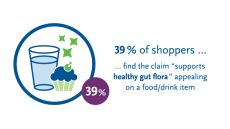Texture of low-fat ice cream boosted by prebiotics
ice-cream, resulting in a potentially health friendly summer snack,
according to new research.
Formulation of a low-fat probiotic ice-cream with inulin resulted in "the best improvement in textural characteristics in terms of firmness, melting properties, and first dripping time," Turkish researchers report in the Journal of Food Science. The study taps into the growing trend of companies moving into the market for more premium products and unusual combinations of flavours in response to stagnation in the European ice-cream sector. This has been due to a maturation of the sector, health concerns and growing competition from cheaper private-label products, according to analysts. Probiotics are bacteria found in the gut that are understood to have health benefits. Prebiotics are ingredients that stimulate growth of probiotics in the gut, and synbiotics are a combination of the two. Most foods containing probiotic bacteria are found in the refrigerated section of supermarkets as the bacteria is destroyed by heat and other processing conditions. This has given the dairy sector, already used to handling live bacteria for the manufacture of yoghurt, a major advantage in probiotic foods - probiotic drinking yoghurts are currently the fastest growing dairy product in Europe. Promising results A.S. Akalin and D. Erisir from the Department of Dairy Technology at Ege University investigated the potential rheological benefits of using inulin in ice cream containing Lactobacillus acidophilus La-5 and Bifidobacterium animalis Bb-12 (Chr. Hansen). Inulin is already used by the food industry as a water binder, emulsifier, stabiliser and texturiser. Inulin (four per cent, Fibruline XL) or oligofructose (four per cent, Fibrulose F97, Cosucra AS) were added to the ice cream and the survival of the probiotics, and general characteristics of the ice cream evaluated after storage at minus 18 degrees C for 90 days. Akalin and Erisir report that addition of both prebiotic fibres "significantly increased apparent viscosity", and affected the melting properties of the resulting ice cream. However, the probiotic ice cream containing inulin exhibited the highest increase in firmness, and the lowest change in melting properties "This study has verified that the highest values for the apparent viscosity, overrun, and firmness and the most remarkable improvement in the meltdown characteristics were obtained in the mix or ice cream containing probiotics and inulin," they added. On the other hand, oligofructose significantly improved the viability of both probiotic bacteria strains, "Although the viable numbers for both bacteria decreased throughout the storage, the minimum level of one million colony forming units per gram was maintained for B. animalis Bb-12 in only ice cream with oligofructose during storage," they stated. Ice cream market According to a Euromonitor study companies in the ice cream market need sensitivity to changing regional tastes, exotic flavour mixes, labelling and packaging to be successful in attacking Western Europe's stagnant ice cream market Sales of ice cream decreased by 0.4 per cent to US$20.3bn in 2004 in the region, according to Euromonitor. Processors are focusing on introducing unusual flavors and premium brands to hold on to their market shares. The trend is known in the industry as the "premiumisation of flavour". More demanding consumers are willing both to experiment with new taste sensations and to pay a higher price for more sophisticated and less traditional products, the analyst said. Source: Journal of Food Science Published online ahead of print, doi:10.1111/j.1750-3841.2008.00728.x "Effects of Inulin and Oligofructose on the Rheological Characteristics and Probiotic Culture Survival in Low-Fat Probiotic Ice Cream" Authors: A.S. Akalin, D. Erisir











